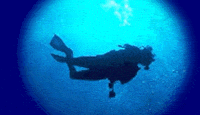|
 On
October 20, 2001 at 12:40 pm, The Honorable Judith Reid, MLA, The
Honorable Mike Hunter, MLA, His Worship Mayor Gary Korpan and John
Ruttan, Chairman of the Nanaimo Port Authority, simultaneously
pushed the two detonation buttons and the Cape Breton cutting charges
were exploded. Moments later a fantastic pyrotechnics show was
enjoyed by several thousand boaters and ferry patrons. It was a
sad, but beautiful sight, to see this mammoth World War ll Naval
Vessel sink in 3 minutes and 37 seconds.The
Cape Breton is the world's second largest artificial reef after
the Speigel Grove in Florida! On
October 20, 2001 at 12:40 pm, The Honorable Judith Reid, MLA, The
Honorable Mike Hunter, MLA, His Worship Mayor Gary Korpan and John
Ruttan, Chairman of the Nanaimo Port Authority, simultaneously
pushed the two detonation buttons and the Cape Breton cutting charges
were exploded. Moments later a fantastic pyrotechnics show was
enjoyed by several thousand boaters and ferry patrons. It was a
sad, but beautiful sight, to see this mammoth World War ll Naval
Vessel sink in 3 minutes and 37 seconds.The
Cape Breton is the world's second largest artificial reef after
the Speigel Grove in Florida!
The
Cape Breton sank perfectly upright, albeit it with a very slight
list to starboard, in 140 feet of water just a few hundred feet  away
from The Saskatchewan. The Crow's Nest is at approximately 40 feet
and is accessible to all divers. The bottom of the engine room
is at 138 feet and is an advanced dive. The engine room will
become British Columbia's signature dive as the engine was
removed leaving a beautiful cavern with cool pipes and catwalks
twisting about. The engine room was my favourite spot to climb
into and think about all the people who had worked on the Cape
Breton and all the miles the ship had traveled around the world. away
from The Saskatchewan. The Crow's Nest is at approximately 40 feet
and is accessible to all divers. The bottom of the engine room
is at 138 feet and is an advanced dive. The engine room will
become British Columbia's signature dive as the engine was
removed leaving a beautiful cavern with cool pipes and catwalks
twisting about. The engine room was my favourite spot to climb
into and think about all the people who had worked on the Cape
Breton and all the miles the ship had traveled around the world.
For
you history buffs, here is a short history of the HMCS Cape Breton.
HMCS Cape
Breton was launched in 1944 at the Burrard Drydock facility in
North Vancouver, British Columbia as the HMS Flamborough Head.
Flamborough Head was one of a series of ships intended to operate
with the British Pacific Fleet in the war against Japan and for
the recolonization of Asian territories. While they were under
construction, the Royal Navy was experiencing a severe manpower
shortage. To this end ,
Sir Winston Churchill attempted to get Canadian Prime Minister
Mackenzie King to provide Canadian crews. This offer was refused
by the wartime Canadian leader for political reasons. Ultimately
the war ended before the whole class was completed and several
completed as merchant ships. HMS Flamborough Head commissioned
into service of the Royal Navy in North Vancouver in 1945. It sailed
from Vancouver and remained in active service with that service
until 1952 when purchased by the Royal Canadian Navy. The ship
commissioned as HMCS Cape Breton at Halifax on January 31, 1953. ,
Sir Winston Churchill attempted to get Canadian Prime Minister
Mackenzie King to provide Canadian crews. This offer was refused
by the wartime Canadian leader for political reasons. Ultimately
the war ended before the whole class was completed and several
completed as merchant ships. HMS Flamborough Head commissioned
into service of the Royal Navy in North Vancouver in 1945. It sailed
from Vancouver and remained in active service with that service
until 1952 when purchased by the Royal Canadian Navy. The ship
commissioned as HMCS Cape Breton at Halifax on January 31, 1953.
Ships
of Canada's Naval Forces 1910-1981 by Macpherson and Burgess states, "She
served at Halifax until August 25, 1958 as a repair ship and training
establishment for technical apprentices. Converted to escort maintenance
ship at Esquimalt, she was commissioned there on November 16, 1959
for service on the West Coast. On February 10, 1964, Cape Breton
was paid off into reserve, but since 1972 she has functioned as
a towed mobile support facility and accommodation vessel at Esquimalt,
designated  Fleet
Maintenance Group (Pacific)." This was undertaken from a semi
permanent position at the old "C" Jetty at the Esquimalt
dockyard; being known unofficially as "Building 100." When
this old dock area was demolished as part of the base redevelopment
of the late 1980's, Cape Breton was berthed across the harbour
adjacent to the Public Works Graving Dock, sometimes referred to
as "D" Jetty. With the completion of the dockyard redevelopment
and the advent of superior shore based facilities, Cape Breton
was declared surplus and assigned to the reserve fleet in Colwood.
Various attempts at returning the ship to peaceable service or
preservation after have not led to fruition. Fleet
Maintenance Group (Pacific)." This was undertaken from a semi
permanent position at the old "C" Jetty at the Esquimalt
dockyard; being known unofficially as "Building 100." When
this old dock area was demolished as part of the base redevelopment
of the late 1980's, Cape Breton was berthed across the harbour
adjacent to the Public Works Graving Dock, sometimes referred to
as "D" Jetty. With the completion of the dockyard redevelopment
and the advent of superior shore based facilities, Cape Breton
was declared surplus and assigned to the reserve fleet in Colwood.
Various attempts at returning the ship to peaceable service or
preservation after have not led to fruition.
|




